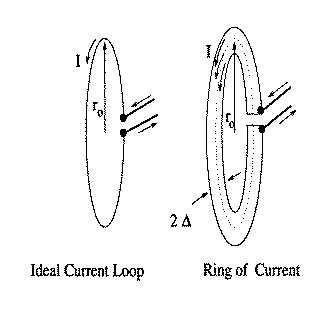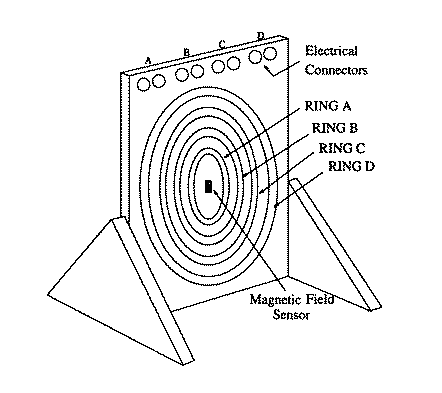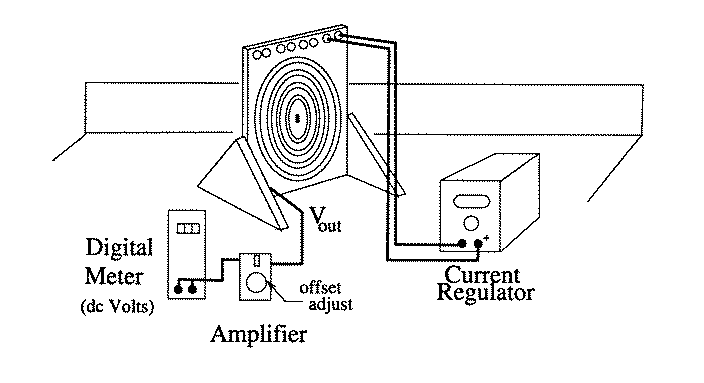PHYSICS 271L Experiment 7
THE MAGNETIC FIELD PRODUCED BY A CURRENT CARRYING RING
[ Theory | Apparatus | Procedure | Questions ]
Purpose: The purpose of this experiment is to measure the magnitude and
direction of a magnetic field produced by current flow in rings.
Supplies: Note paper, graph paper and calculators.
Reference: Halliday, Resnick and Krane, Physics, Chapter 35.2. Halliday, Resnick and Walker, Fundamentals of Physics, pp. 731-32.
Theory: Electric Current and Magnetic Fields
In 1819, Oersted first discovered that a current-carrying wire affected the position of a compass needle, establishing the first link between electricity and magnetism. Oersted's work opened the door for further experiments by Ampere who showed in 1820 that a force exists between two current-carrying wires. We now know these two important experiments can be explained in terms of the magnetic field produced when current flows through a wire.
A fundamental result that has emerged from these studies is that in
free space, a magnetic field ![]() is
produced at a point
is
produced at a point ![]() , whenever a current I flows
through a segement
, whenever a current I flows
through a segement ![]() of a wire. We know
that the net magnetic field
of a wire. We know
that the net magnetic field ![]() is
determined by the Biot-Savart equation
is
determined by the Biot-Savart equation
![]() (1)
(1)
where ![]() is a fundamental constant equal to
is a fundamental constant equal to ![]() .
.
For certain well-characterized geometries, the Biot-Savart equation yields an analytical result for the magnetic field. For instance, in the case of current flowing through a thin circular wire loop, the magnitude of the magnetic field at the center of the loop is given by
![]() (2)
(2)
In Eq. 2, I is the current through the loop in Amperes and ![]() is the radius of the loop in meters. Since the magnetic field is a
vector, it has a direction which is set by the direction of the conventional current flow
and the right hand rule.
is the radius of the loop in meters. Since the magnetic field is a
vector, it has a direction which is set by the direction of the conventional current flow
and the right hand rule.
In a laboratory situation, it is often difficult to pass enough current through a single thin wire to produce a magnetic field sufficiently large to measure accurately. Either many turns of wire are required or the wire `loop' must resemble a ring which has a radial width 2D as shown in Figure 1. In this case, the mean radius is given by r0 = (rinner + router )/2, while the radial width is defined by 2D= (rinner - router ). If the radial width of the ring is a sizeable fraction of the radius of the ring, then corrections are required to Eq. 2.

Figure 1. An illustration of an ideal current carrying wire loop having a small wire diameter when compared to the loop's radius (ideal case). Also shown is a loop with a finite radial width equal to 2D. A small cut must be made in the loop to allow a dc current I to flow.
For the experiments you will perform in this lab, these corrections are important, especially for rings with smaller radii. The exact formula for the magnetic field in this case is given by
 (3)
(3)
where a is a proportionality constant (the field constant of the ring, units of T/A) that depends only on geometry.
The rings you will be using have a well-defined geometry, so the geometrical factors important in Eq. 3 can be calculated in advance. The following table provides some useful information.
Table 1: Ring dimensions and correction factors.
| Ring ID | rinner | router | r0 | D |  |
| A | 1.842 cm | 2.413 cm | 2.128 cm | 2.86´ 10-3 m | 0.270 |
| B | 3.162 cm | 4.128 cm | 3.645 cm | 4.83´ 10-3 m | 0.267 |
| C | 5.080 cm | 6.033 cm | 5.557 cm | 4.77´ 10-3 m | 0.172 |
| D | 7.620 cm | 8.560 cm | 8.090 cm | 4.70´ 10-3 m | 0.116 |
Apparatus: Experimental Considerations
The experimental apparatus consists of four concentric copper rings mounted inside a Plexiglas holder. A schematic of the apparatus identifying the various rings is shown in Figure 2. Each ring has a small slit cut through it to allow current flow. At the center of the Plexiglas holder is a sensitive magnetic field sensor that produces a voltage proportional to the magnetic field perpendicular to the plane of the sensor. The active area of the sensor is very small, approximately 0.4 mm ´ 0.4 mm, so your magnetic field measurements will be reasonably local and not some ill-defined spatial average that is difficult to interpret.
An amplifier is required to amplify the voltage produced by the magnetic field sensor (it is a Hall sensor made by MICRO SWITCH; Model SS94A1F). The output voltage of the amplifier is very sensitive to magnetic fields, and care must be taken to adjust the offset of the amplifier to zero to null out the earth's magnetic field. Since the zero drifts with time, you must constantly monitor this value while taking data. It is a good idea to turn the amplifier on as soon as you enter the lab. It takes about five minutes for the electronics to reach steady state and during this time the zero drift is large. If the pink light in the switch does not glow, a new 9 V battery is required.
The amplifier and magnetic field sensor used here combine to produce an output of 1.563 ´ 103 V/T (0.1563V/gauss). Whether the voltage out of the sensor is positive or negative depends on the direction of the magnetic field produced by the current flowing through the ring. The output voltage can be measured with a Model DM15XL Wavetek digital voltmeter set to measure 2 V dc full scale.

Figure 2. A schematic diagram showing the apparatus used in this experiment.
The current through the rings is obtained from a regulated power supply. A 10-turn potentiometer allows you to adjust the current to any desired value between 0 and roughly 8 A. An ammeter integrated into the current regulator provides an accurate measure of the current. Note: If you disconnect the rings from the power supply while current is flowing, the power supply may shut down. If this happens, turn the power supply off for about ten seconds to allow the internal circuitry to reset.

Figure 3. A schematic diagram showing how the equipment should be setup.
You are now ready to perform the following experiments:
Experiment I
The purpose of this first experiment is to familiarize yourself with the experimental apparatus. First, if you haven't already done so, turn on the switch to the amplifier that powers the magnetic field sensor and allow it to stabilize. This will require about five minutes. During the first few minutes of operation, the drift in the output of the amplifier is electronic in origin. Verify that the output of the magnetic field sensor can be set to zero by adjusting the `offset adjust' knob on the amplifier. Use the Wavetek digital voltmeter set to the 2 V dc setting to monitor the output voltage.
While you are waiting for the electronics to stabilize, connect the apparatus as shown in Figure 3. Take the compass and first check it out by placing it near a window or by going outside to find a place that is not surrounded by steel. Does the needle point North? If it doesn't, it probably has been permanently magnetized and may give you false indications. After verifying that the compass works as expected, place it near the center of the rings. Use a wooden block to provide a non-magnetic support for the compass. Move the apparatus (i.e. rotate the ring apparatus on the table) until the compass needle is approximately parallel to the plane containing the rings. Make sure any bar magnets are far away from the apparatus.
Apply a dc current of about 8 A to Ring B and move the compass along a line parallel to the Plexiglas ring holder with your hand. Keep the compass at a height to be near the ring's center. Note the motion of the compass needle as you move the compass back and forth in front of the rings. Move the compass behind the apparatus. Repeat the same procedure. By inspecting all the wires, make sure you know the direction of the conventional current flow that produces a North or South magnetic pole from the ring. From the definition of the North and South magnetic pole, you can determine the direction of the magnetic field lines produced by the current flowing through the ring. Make clear sketches of all this and include them in your lab report.
Experiment II
By now, the drift in the amplifier electronics should have stopped, so readjust the voltage output from the magnetic field sensor to zero using the `zero offset' knob. To calibrate magnetic field direction, place the compass on the wooden block and locate it near the center of the rings. Move a bar magnet into the vicinity of the detector (maintain a distance of about 10 cm). Note the polarity of the voltage on the digital voltmeter. Now flip the bar magnet so the other end of the magnet is pointing toward the sensor. What happens to the polarity of the output voltage? Use the poles of the bar magnet to correlate the polarity of the sensor voltage with the direction of the magnetic field.
Remove the compass and determine the magnitude of the magnetic field produced by the bar magnet as a function of distance. Place the bar magnet about 10 cm away from the sensor and record the sensor voltage measured on the digital voltmeter. Adjust the position of the bar magnet and record the readings for about six different distances between the sensor and bar magnet.
Experiment III
The purpose of this experiment is to measure the magnetic field produced by rings of different radii. Before proceeding, remove the bar magnet and compass from the ring apparatus. As a precaution, check (and readjust to zero, if necessary) the output voltage of the amplifier between sets of measurements. Make sure the current through the rings is zero when you do this. After reaching equilibrium operating conditions, the zero should remain reasonably stable during the course of the experiment. If you move the Plexiglas ring holder from its initial position on the table, the zero must be readjusted (Why?). Take precautions now to make sure this does not occur while performing your measurements.
Use the power supply provided to supply current to each of the four rings in succession. You will be required to change the direction of the current flow in the rings during this part of the experiment. Measure the voltage from the amplifier as a function of the current through each ring. Record your data. Use current values between -8 A and +8A in increments of 2 A.
Experiment IV
In this experiment, you will measure the vector addition of magnetic fields by passing current through more than one ring. For this experiment you will pick a combination of two rings, e.g. Rings B and C, and apply current in different directions to the rings when they are connected in series. First, connect the rings so that the conventional current flow through BOTH rings is in the same (e.g. clockwise) direction. In order to do this, you must pay attention to the way ALL the wires are connected. Measure the output voltage of the magnetic field sensor for a current of 5 A. Remember to adjust the amplifier offset to zero. Record your data.
Now reverse the current flow in only ring B by dialing the current to zero and reversing the appropriate connecting wires. Note: If you disconnect the rings from the power supply while current is flowing, the power supply may shut down. If this happens, turn the power supply off for about ten seconds to allow the internal circuitry to reset.
Make sure you understand which ring has a clockwise (CW) current flow and which ring has a counter-clockwise (CCW) current flow. Record the voltage from the magnetic field sensor for a current of 5 A. Make sure you understand the numbers that you record. Repeat this procedure, but now re-wire the rings so that current flows CCW in Ring C and CW in Ring B. Record the voltage from the magnetic field sensor for a current of 5 A. Finally, arrange the wires to the rings so that current flows in a CCW direction in BOTH rings. Again, record the voltage from the magnetic field sensor for a current of 5 A.
Lab Report and Questions:
The following questions might be considered when writing your lab report:
Experiment I: Direction of the compass needle
Draw a qualitative picture that summarizes your experiment. Be sure to include the ring, the direction of conventional current flow, and the direction of the compass needle at different positions in front and behind the ring.
Experiment II: The bar magnet
Plot the strength of the magnetic field as a function of distance from the bar magnet. What component of the field are you measuring? Can you write down an equation that describes how the magnetic field varies as a function of position? Specify the direction of the magnetic field as clearly as possible.
Experiment III: The magnetic field from a current carrying ring
Tabulate your data and make a plot to show how the magnetic field at the center of each ring varies with current. Does your data agree with the predictions of Eq. 3? Measure the slope of the straight line through your data and record it in a table. This is the field constant of the coil. Also, calculate the coefficient a in Eq. 3 relating the magnetic field to the current and record this in a table. Calculate the percentage error between your measured value and theory. Is the difference between theory and experiment significant? If there is a significant discrepancy, how do you explain it?
Experiment IV: The vector addition of magnetic fields
Make a table showing how the magnetic field varies as a function of the direction of the current in each of the two rings. Why does the magnitude of the magnetic field decrease when you change the direction of the current in one of the rings? Draw a simple figure to help illustrate your explanation. Use the experimental results for the individual rings (Exp. III) to explain the results that you obtained in this part of the lab.
Miscellaneous Questions
In W. Lafayette, the earth's magnetic field is about 0.5´ 10-4 T. In this experiment, the magnetic fields produced by the rings are of the same order of magnitude. How did you take into account the earth's magnetic field when analyzing the data obtained in this experiment?
Do the magnetic fields generated by the connecting wires in this experiment influence your measurements? If you answer yes, what precautions did you take to minimize their effect?
[ Top ]